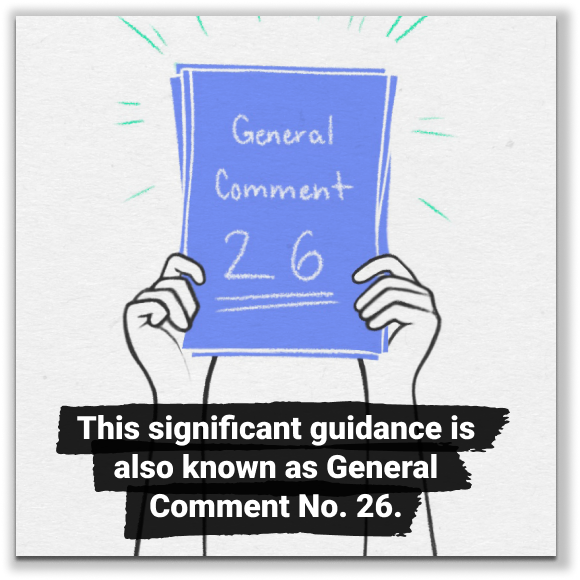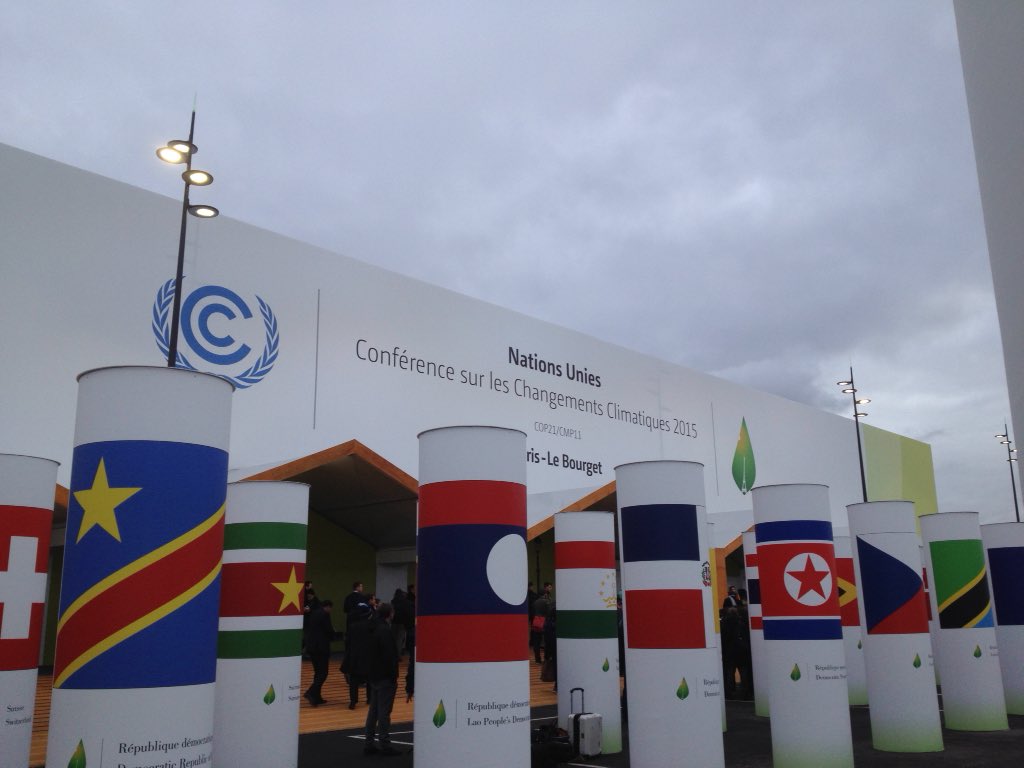 On August 28, 2023, the United Nations Committee on the Rights of the Child (UNCRC) published General Comment No. 26 (GC26) on children’s rights and the environment with a special focus on climate change. A general comment, despite non-binding, provides an authoritative interpretation of human rights treaty provisions – in this case, related to the Convention on the Rights of the Child (CRC) – and seeks to clarify and suggest approaches to implementing them. The CRC is the most widely ratified human rights treaty, with 196 parties. Notably, the United States remains the only eligible country not to have ratified the treaty.
On August 28, 2023, the United Nations Committee on the Rights of the Child (UNCRC) published General Comment No. 26 (GC26) on children’s rights and the environment with a special focus on climate change. A general comment, despite non-binding, provides an authoritative interpretation of human rights treaty provisions – in this case, related to the Convention on the Rights of the Child (CRC) – and seeks to clarify and suggest approaches to implementing them. The CRC is the most widely ratified human rights treaty, with 196 parties. Notably, the United States remains the only eligible country not to have ratified the treaty.
GC26 aims to highlight the urgency of addressing adverse impacts on children’s rights from environmental degradation while fostering a holistic understanding of these rights and providing authoritative guidance to states on measures to counter environmental harm, especially in the context of climate change. This blog post provides an initial assessment of the comprehensive coverage of GC26, shedding light on its inception and the driving forces behind its development. The post further explores the potential implications of this clarification for climate litigation, while highlighting the key provisions that underscore the responsibilities of states in safeguarding children’s rights within the ever-evolving environmental landscape.
Background
Sacchi et al. v. Argentina et al.
In 2019, 16 young individuals lodged five complaints to the CRC contending that five nations had violated their obligations as outlined in the UNCRC by (i) neglecting their duty to prevent foreseeable domestic and transboundary human rights transgressions linked to climate change, primarily through emissions reduction; (ii) failing to engage in international collaboration to address the exigencies of the climate crisis; (iii) neglecting the application of the precautionary principle to shield life in situations of uncertainty; and (iv) not ensuring intergenerational equity for the younger generation (Sacchi et al., v. Argentina et al.).
In 2021, the CRC dismissed the complaints since the petitioners had failed to exhaust domestic legal remedies at the national level. Still, the decision holds significant implications for safeguarding children’s rights within the climate change context and set a foundation for future climate-related cases centered on children. Notably, the CRC’s pronouncements on jurisdiction and extraterritorial responsibility contribute to these advancements. Furthermore, the CRC underscored the foreseeable nature of harm stemming from states’ carbon emissions, supported by established scientific evidence. As noted elsewhere, the decision set a crucial precedent and kickstarted internal debate within the CRC on the effects of environmental harm and climate change on children, eventually leading to the publication of GC26.
Consultations
GC26 was published after almost two years of consultations with children and experts, including through questionnaires, thematic and local workshops, and online consultations. The Sabin Center co-hosted a consultation on the rights of children and climate change to inform GC26 with Terre des Hommes and Child Rights Connect in February 2022. The consultation, which was part of the first drafting phase of the GC, included a thematic workshop with several experts on climate change law, climate change litigation, and their intersection with the rights of children. Climate change litigation was a central subject of the consultation, significantly influencing the content and structure of the General Comment. Informed by the Sabin Center’s annotated bibliography and an accompanying list of youth-based climate litigation cases, the insights garnered from these consultations played a pivotal role in shaping the guidelines related to nations’ responsibilities in safeguarding the rights of children within the realm of the environment. These consultations were instrumental in bridging knowledge gaps concerning crucial legal aspects and clarifying certain concepts such as the rights of future generations.
Children’s Perspectives
Of paramount significance to the development of GC26 was the incorporation of the perspectives of children and young individuals who bear the brunt of the consequences of climate change. Illustratively, in the first phase of consultations, one child participant noted: “Add information about climate change to the current school curriculum so that all children and youths can attain first hand information on climate change” (see consultation report p.28). This is reflected in §53 of the GC26 on the right to education, which refers to environmental education and the need for school curricula to be tailored to children’s specific environmental, cultural, and socioeconomic contexts (see J. §§51-57 GC26). Notably, children’s contributions to GC26 are not limited to content. Children shared with their own voices, and with powerful words, their concerns over the climate crisis: “Yes, I would like to tell them [adults] that we are the future generations and if you destroy the planet, where will we live?!!!!” (see consultation report p.16). Their participation in the consultations had an intrinsic value, influencing and inspiring the whole process up to the publication of GC26.
Environmental Harm and Children’s Rights
As climate scientists continue to report the disproportionate impact of climate change and environmental degradation on children and future generations, GC26 could not come at a better time. New studies estimate that children born in 2020 will experience up to a sevenfold increase in climate-related extreme events compared with people born six decades ago. The systemic threats of what the Committee describes as a “triple planetary crisis”, referring to the climate emergency, biodiversity loss, and pollution (see I. §1 GC26), on children’s rights are evident. These do not only concern their rights to life, survival, and development (art. 6), and the highest attainable standard of health (art. 24), which will be significantly challenged by the more frequent climate-related catastrophes, excessive water, air, and soil pollution, and environmental degradation. Specifically, the Committee recognized – in alignment with the U.N. General Assembly’s 2022 resolution and the Human Rights Council’s 2021 resolution – that “a clean, healthy and sustainable environment” is a human right and necessary for the full enjoyment of a broad range of children’s rights (I. A. §8 GC26).
The intensity of the climate and environmental crisis, if unabated, will threaten all children’s rights under the Convention, including rights that have an instrumental role in safeguarding and realizing their environmental rights, such as their right to education (art. 28 and 29 (1) (e)); see II §§13, 51 GC26), and their right to be heard and participate in all matters affecting their wellbeing (art. 12; II §§26-28 GC26), linked with their rights to information (art.17), freedom of expression (art. 13), association and assembly (art.15) (II. F. §32 GC26; see also Lansdown).
Child Participation
The Committee highlights that in the context of environmental and climate crisis, “the process of realizing children’s rights is as important as the result” (I. A. §7 GC26), as also seen in academic commentary focusing on children’s rights-compliant processes in climate litigation. True to its statement, the Committee placed the voices and views of children at the heart of GC26 since its conception, consulting thousands of children around the world. In the second thematic consultation on the draft GC26 in March 2022, the Committee also asked the participants in the discussion circles how it could support child participation amid the environmental crisis. Importantly, in GC26, the Committee notes that children’s active exercise of their rights can lead to more rights-compliant environmental policies which in turn protect children’s rights completing a “virtuous circle” (I. A. §8 GC26). By illustrating this symbiotic relationship, together with the recognition that children’s rights are “indivisible, interdependent and interrelated” (II. §13 GC26) the Committee in GC26 advances a holistic understanding of children’s rights, including their right to be heard, while offering opportunities for strengthening child participation.
Children’s Voices and Participation
The Committee acknowledges children’s voices as “a powerful global force for environmental protection”, asking states to ensure their participation in all relevant stages of environmental decision-making, and highlighting the link between child participation, education, and access to information (II. D. §§26-28 GC26). Significantly, the Committee comments on the inclusivity of child participation, with children’s views expressed through creative forms of expression, such as art and music (II. D. §§26-28 GC26), building on its earlier comments in General Comment No.12 (2009) (see §21).
Additionally, the Committee links child participation with determining children’s best interests in environmental decisions having a significant impact on children’s lives, noting that in such cases “a more detailed procedure to assess and determine children’s best interests that provides opportunities for their effective and meaningful participation, is appropriate” (II. B. §16 GC26; see also IV. B. §77, D. §83 GC26). That is consistent with the significance of participation as an underlying determinant of health and wellbeing as expressed in international human rights law (see illustratively CESCR General Comment No. 14 (2000) §§3, 4, and 11). It also recalls the Committee’s innovative approach in Sacchi, where the children authors of the communication were invited to share how climate change affects their lives directly in an oral hearing, followed by issuing a child-friendly version of the decision in the form of a letter. A child-friendly version of the GC26 is to be published on 18 September 2023. Overall, these procedural innovations and the prominence of children’s voices in the drafting process and wording of GC26 are promising indications for the development of child participation in the context of climate change and beyond.
Climate Change & Intergenerational Equity
The intergenerational inequities exacerbated by climate change are an unavoidable part of the discussion on climate change. The increasingly thickening trends of youth climate litigation with a focus on the rights of future generations, as reported in the Sabin Center database, is a testament to that. Indeed, the focus on intergenerational rights in climate litigation has been so strong that children’s experiences in the here and now may not have been sufficiently addressed, and child specific arguments have been underutilized (see Donger). The Committee acknowledged the principle of intergenerational equity, which features prominently in youth climate litigation, and the interests of future generations (I. C. §11 GC26). Additionally, the Committee highlighted the states’ responsibility for future and foreseeable environment-related threats (I. C. §11 GC26), with due regard to the precautionary principle (IV. A. §69 GC26), which could be important in terms of bringing future climate claims before the Committee and other judicial bodies. However, it did not define the concept of future generations nor clarify the relationship between children’s rights and future generations’ rights, which has become the topic of scholarly discussion (see Nolan; Daly).
GC26 and Climate Litigation
As noted, the move towards clarifying the states’ obligations towards children to counter the triple planetary crisis was sparked by children and youth litigation. With over 40 cases, this subset of climate litigation, defined by the plaintiffs bringing forward these claims, has been the focus of recent scholarship (see Donger; Parker et al.; Abate). Just last month, in Held v. State, a Montana state court held that Montana Environmental Policy Act has harmed the state’s environment and was unconstitutional by preventing Montana from considering the climate impacts of energy projects. The case was led by 16 young Montanans, aged 5 to 22, who brought the nation’s first constitutional and first youth-led climate lawsuit to trial.
Recognizing this trend, the GC recognized children as “agents of change” (I. §4 GC26), which reflects their important role in climate change litigation. Significantly, the GC26 recognized the obligation of all countries signatory to the CRC to protect children from environmental degradation, identifying it as a form of “structural violence against children” (II. G §35 GC26). This recognition further strengthens children’s claims in climate litigation cases.
Conclusion
The product of extensive intergenerational collaboration between children, youth, experts, and member states, GC26 highlights by example that the process of protecting children’s rights is as important as the result, while revealing critical possibilities for children’s role in environmental decision-making. By advancing a holistic approach to children’s rights and clarifying the responsibilities of states, GC26 constitutes a significant legal tool for a child-centered approach to environmental protection and an asset to the increasing numbers of child-focused climate litigation. GC26 provides the first authoritative guidance on child-centered environmental rights, explicitly acknowledging the right to clean healthy sustainable environment. These recognitions will be crucial in achieving further climate action from states and corporate actors, especially through climate litigation.






